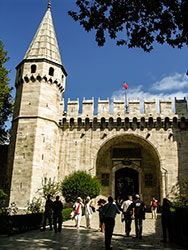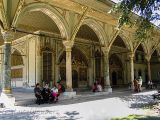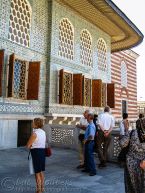Historical Background
Shortly after the conquest of Constantinople, Mehmed the Conqueror began the construction of a new palace on the hill where in antiquity the acropolis of Byzantium was located. For almost four centuries, until Sultan Abdülmecid I moved his residence in 1853 to Dolmabahçe Palace, the sultans lived in the Topkapi Palace (Topkapı Sarayı in Turkish) or Seraglio as it became known in the West. Unlike European palaces, Topkapı Sarayı, meaning Gate of the Cannon, is actually a large complex of pavilions and gardens built around 4 major courtyards. One of those pavilions was a shore palace that was known as the Topkapi shore palace, as it was situated near the cannon gate - Top Kapı - of the ancient walls of Istanbul. When this shore palace burned down in 1863, it lent its name to the great complex we now know as Topkapi Palace. In 1924 the palace was reopened as a museum by Mustafa Kemal Atatürk.
Sights & Photos of Topkapı Palace
If you visit first Gülhane Park and the Archaeological Museums Complex, then you arrive immediately in the first court at the main entrance to the palace that is formed by the Bab-üs-Selam (Gate-of-Greeting), also known as Ortakapı (Middle Gate). The Bab-üs-Selam leads to the second courtyard, the Divan Meydanı. Here are the imperial kitchens, where part of the palace's collection Chinese celadon porcelain is exhibited. Opposite, at the west side, is the Kubbealtı (meaning under the dome) or Divan Salonu where the Imperial Council or Divan used to meet. Next to it is also the entrance to the famous harem. The word harem in Arabic means forbidden and refers to the private section of a household where women live and work. The harem of the Topkapi palace was like a labyrinth composed of 400 rooms, 10 bathrooms (hamam), fountains, corridors and secret passages.
The Bab-üs-Saadet or Gate-of-Felicity leads to the third court (Enderun) of the Topkapi Palace with its various pavilions. Here is also the Treasury Room located where the world-famous emerald sheathed Topkapi dagger and the 86 carat Kaşıkcı or Spoon Maker's diamond, surrounded by 49 brilliants, are on display (photography not allowed).
The Konyali restaurant and cafeteria is the place for a rest, some refreshments, an excellent meal, and a breath-taking view of the Bosphorus. A covered path leads from the Treasury Room to the fourth court with the Lale (Tulip) garden, the Baghdad Pavilion and the Iftariye Kiosk. The elegant Iftariye or Kameriye Kiosk bears the inscription 1640. This gilded porch was, during summer, the chosen site for the sultan during Ramazan - the month of fasting - towards sunset and the end of the daily fast. Next to it, the Baghdad Pavilion is octagonal in plan with two doors that open up to a single chamber. The pavilion dates from 1639 and owes its existence to the Baghdad Campaign of Sultan Murat IV during which it was built. It was used as a coffeehouse for the sultans.
We leave the palace through the Bab-i Hümayün or Imperial Gate, the first gate which is actually the main entrance to the museum for organized tours. Just outside Topkapi palace, there is the very elegant Sultan Ahmet Çeşmesi. This fountain was built on the command of Ahmet III in 1728 and is, without doubt, the most beautiful of its kind. Its projecting roof is topped with five small domes, and the monument is decorated with beautiful tiles and fine inscriptions.
https://www.turkeyphotoguide.com/topkapi-palace?tmpl=component&print=1&page=#sigProIda5e2a22a34



























